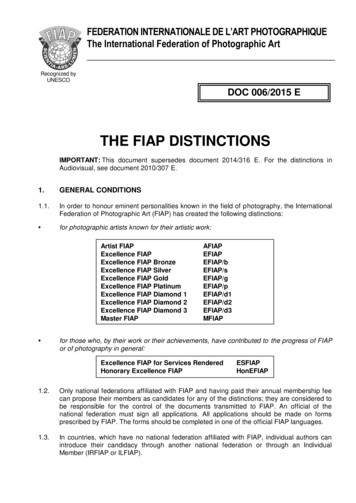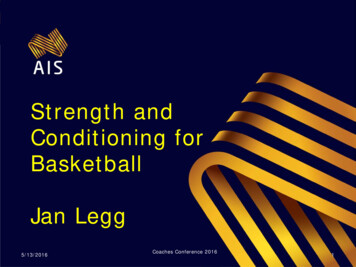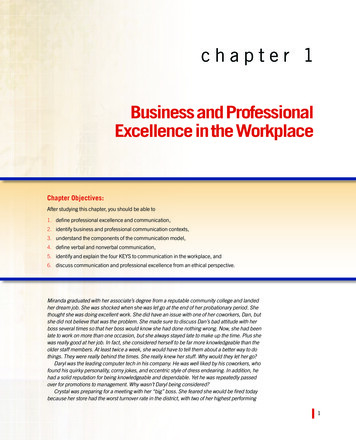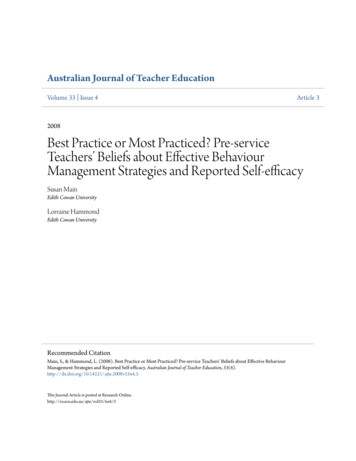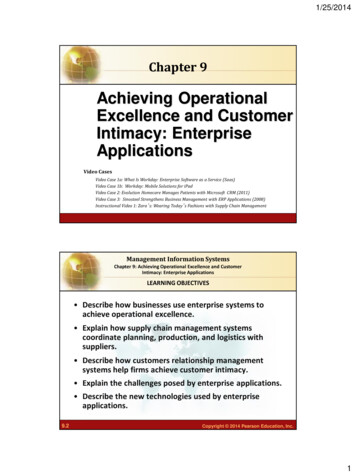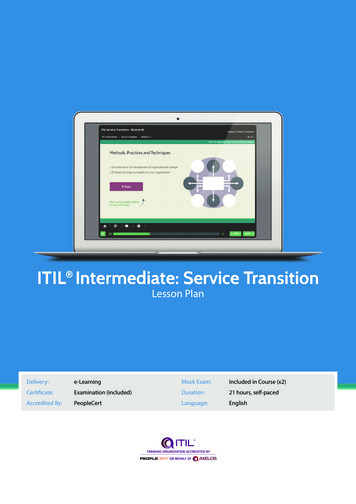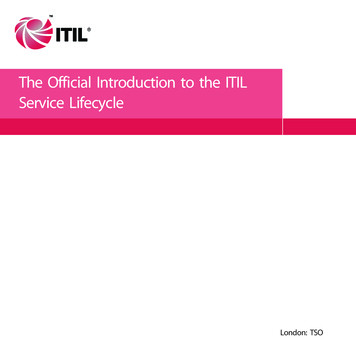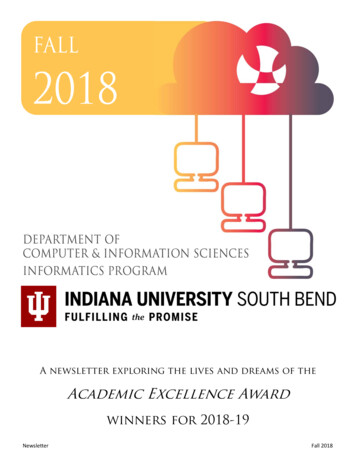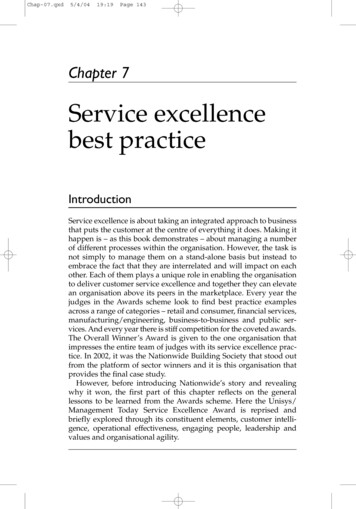
Transcription
Chap-07.qxd5/4/0419:19Page 143Chapter 7Service excellencebest practiceIntroductionService excellence is about taking an integrated approach to businessthat puts the customer at the centre of everything it does. Making ithappen is – as this book demonstrates – about managing a numberof different processes within the organisation. However, the task isnot simply to manage them on a stand-alone basis but instead toembrace the fact that they are interrelated and will impact on eachother. Each of them plays a unique role in enabling the organisationto deliver customer service excellence and together they can elevatean organisation above its peers in the marketplace. Every year thejudges in the Awards scheme look to find best practice examplesacross a range of categories – retail and consumer, financial services,manufacturing/engineering, business-to-business and public services. And every year there is stiff competition for the coveted awards.The Overall Winner’s Award is given to the one organisation thatimpresses the entire team of judges with its service excellence practice. In 2002, it was the Nationwide Building Society that stood outfrom the platform of sector winners and it is this organisation thatprovides the final case study.However, before introducing Nationwide’s story and revealingwhy it won, the first part of this chapter reflects on the generallessons to be learned from the Awards scheme. Here the Unisys/Management Today Service Excellence Award is reprised andbriefly explored through its constituent elements, customer intelligence, operational effectiveness, engaging people, leadership andvalues and organisational agility.
Chap-07.qxd5/4/0414419:19Page 144Business success through service excellenceCustomer intelligence – summaryService excellence is underscored by a compelling business philosophy that promotes the establishment of long term, mutually trustingand profitable relationships with customers. The first step to buildingthis philosophy within an organisation is to have in place processesto generate customer intelligence. The aim of these activities is todevelop a sense of customer intimacy, and Chapter 2 explored theways in which organisations build their knowledge and understanding of their customers’ needs and expectations, and how customers perceive the performance of the organisation. These wereillustrated through the cases of Woburn Safari Park and RackspaceManaged Hosting.While no one research tool or technique provides absolute customerintelligence – organisations need to blend a portfolio of methods in anongoing process – this information provides an essential foundationon which the organisation can build its offer to customers, and affordsan insight into the changes in products and services that customersmay be looking for. It helps provide insight into customer motivationsto buy, and can supply knowledge and understanding of the competitive frame within which the organisation operates. This informationcan be leveraged through the process of segmentation, which works toportion the market and identify the most profitable sectors (howeverthey may be defined) on which to concentrate the organisation’sresources. This process is essential as it enables the organisation to beconfident about the market in which it operates, providing the answerto the simple but strategic question, ‘What business are we in?’Adopting this outside-in approach to strategy development enablesthe organisation to define the value customers are seeking from thecustomer’s perspective. Organisations need to understand how customer value is made up: the elements that maintain value, the valueenhancers and the value destroyers. This chapter also examined thenotion that innovation in service excellence is about creating newsolutions (in how the organisation does something as much as what itdoes) that are acknowledged by customers as offering real value.Customer intelligence best practice organisations, like WoburnSafari Park and Rackspace, are able to respond positively to thefollowing statements: We encourage and act on feedback from customers.We understand the drivers of customer satisfaction.
Chap-07.qxd5/4/0419:19Page 145Service excellence best practice 145We are recognised as innovators in our market.We build long-term profitable relationships in our chosen markets.We monitor and track customer retention and repurchase intention.Operational effectiveness – summaryChapter 3 established that customers continue to turn to particularcompanies because they are easy to do business with. For organisations, achieving this means creating their value offering around anunderstanding of exactly what it is customers desire. Best practiceorganisations express this in terms of the four Cs (customer needsand wants, cost, convenience and communication), rather than thefour Ps (product, price, place and promotion). This understandingthen forms the focus of the organisation’s activities. In manyrespects, it means turning the supply chain on its head and thinkingabout taking the customer as the point of departure for the organisation, and not its final destination. Making this an operationalreality is then dependent on the effectiveness of service deliveryprocesses and programmes.For many organisations, the aim of operational effectiveness is todeliver the ‘perfect customer experience’ on every occasion. This isnot, however, a single event but is best conceptualised as an ongoingprocess. And in order to ensure that service delivery processes andprocedures are optimised, best practice organisations use one ormore sets of tools and techniques to promote continuous improvement. These may include benchmarking, the International StandardsInstitute’s ISO 9000 series or Six Sigma. This latter approach, basedon established techniques developed in manufacturing, has beenpopularised through the impact it has had on the Motorola and GEbusinesses. Essentially, Six Sigma is a statistically based, organisation –wide approach to quality improvement that aims for a maximumnumber of error-free transactions, generally expressed as so manyper million occurrences.Awards winners take this data driven-approach very seriouslyand also ensure that they can track the cost of servicing a single transaction; and many also track the costs of non-conformance. These arethe costs incurred when the organisation fails to do things right firsttime. These may include costs of rework, administering complaintsor discounts or refunds to customers.
Chap-07.qxd5/4/0414619:19Page 146Business success through service excellenceOperational effectiveness has become a lot more complex in lightof the proliferation of media and channels. And for organisationswith a multimedia/multi-channel strategy, their goal is to ensurethat the customer has a perfect experience across all the media andchannels they offer. Each time the customer comes into contact withthe organisation, they should feel like they are talking to the sameperson. Too many organisations forget this when it comes to integrating the web into the service offering – for them it offers an opportunity to cut costs rather than enhancing the customer’s experience.Finally, organisations need to manage their customer complaints –excellent complaint handling consists of three key operational activities: dealing with the customer, solving the problem for the customer,and dealing with the problem within the organisation. A philosophy of proactive service recovery can work to improve serviceexcellence.TNT and the Dental Practice Board illustrated best practice inoperational effectiveness and are typical of Awards winners whocan state unequivocally that: Customers consider us easy to do business with.We enhance business performance through continuous improvement.We can deal equally effectively with customers over multiple channels.We deal with service failures effectively.We use the web to enhance the customer’s experience.Engaging people – summaryThis chapter looked at the role of employees in creating and delivering service excellence. For many organisations, the quality and history of the relationships that staff have with customers remains themost unique aspect of their business. Competitors can copy manyother elements but are less likely to succeed here. It is, therefore, notsurprising that engaging people in the organisation has become aboardroom agenda item.This represents a shift away from the time when the businessenvironment was dominated by manufacturing and employeeswere regarded as a production cost that needed to be controlled andreduced. Today, service-based organisations recognise that theiremployees are, in fact, a capital asset whose intrinsic value can begrown, and their approach to employee management reflects this.
Chap-07.qxd5/4/0419:19Page 147Service excellence best practice147It is accepted by best practice organisations that employee behaviour, whether it directly or indirectly impacts the customer, plays acritical role in determining the level of service excellence that isexperienced by customers. This will, in turn, influence customers’level of satisfaction with the company and affect their willingness toeither remain with or defect from the organisation. The extent towhich quality employees can be attracted, kept and motivated istherefore directly linked with the organisation’s capacity to offerquality services to their customers.Engaging people starts with having a vision within the organisation that forms the focal point of a climate and culture that inspiresthe hearts and minds of all employees. In best practice organisationsthis vision is communicated through all stages of the recruitment,training and retention process. Many service excellence companiesbelieve in the careful selection of staff and search for individualswhose values and motivation match the organisation’s service ethic.They adopt the philosophy that employee suitability should not justbe based on technical skills, which can be taught later, but on characteristics which show a positive service attitude. And once theybecome an employee, the organisation then works to ensure thatindividuals have the right skills and knowledge to perform theirwork well. Best practice organisations distinguish themselves in thisrespect by going beyond the provision of training, which takes anorganisation only so far, and creating a learning environment fortheir staff. This is characterised by a repeated pattern of study andpractice, where learning effectiveness is measured by testing theresults of what employees do, rather than measuring training effectiveness through testing people.In high performing organisations, employee satisfaction is takenas seriously as customer satisfaction and reward, recognitionand empowerment feature as a part of the organisational culture.These are organisations like case study exemplars PetCareCo andJohn Pring & Son who are able to respond positively to the following statements: Our people have the right skills and knowledge to perform theirwork well.We regularly monitor employee satisfaction and act on the findings.We recognise the performance and behaviour of outstanding individualsand teams.We empower our people to deliver service excellence.When recruiting and developing people we focus on attitude first.
Chap-07.qxd5/4/0414819:19Page 148Business success through service excellenceLeadership and values – summaryChapter 5 positioned leadership and values as the cornerstone of theService Excellence Awards as they are intrinsically linked with thedirection and culture of the organisation. How an organisation isled and managed determines its position within the marketplace.Leaders are not, however, the same as good managers; managersmay have a certain amount of power and responsibility but this doesnot mean that they inspire people to follow. This is the hallmark ofleaders – they generate what has been called ‘followship’.‘Followship’ is defined as a ‘capability to lead [that] must be coupledwith the practical skills that leaders need to have to manage theirday-to-day affairs’. Among the skills that leaders need to demonstrateis an ability to command and focus resources on the attainment of aparticular vision. This is a statement that provides the answer to thequestion ‘where are we going?’ It needs to become a shared idea ofwhy the organisation exists and what it wants to achieve.It is also important that leaders reflect the values of the organisation, in other words the preferred behaviours that will guide theorganisation on its journey. Allied to this is a need for a high degreeof people skills, to be able to manage the complex human interactions that take place within organisations, as well as good conceptual skills and sound judgement.The values of an organisation are sometimes referred to as the‘ethos’ of a business, or the ‘principles’, ‘guidelines’ or ‘rules’, andwhile the vision may change, values should stand the test of time.Their purpose is to guide behaviour within the organisation andwhere they are ‘lived’ by employees, organisations find that theycome to rely less on formal rules and regulations. Staff understandwhat is expected from them, they know how to behave and how torespond to new or unforeseen circumstances.However, there is often a gap between the values espoused by anorganisation and the values customers and employees experience ineveryday life. These are organisations where what gets preacheddoes not get practised. Service excellence organisations work to narrow and, where possible eliminate, this gap. Senior managers whoactively champion customers can play a crucial role in achievingthis. Another fundamental differentiator of service excellence organisations is that their values feature the customer in at least one oftheir value statements. In too many organisations, references to thecustomer are missing.
Chap-07.qxd5/4/0419:19Page 149Service excellence best practice149The roles of leadership and values were explored in some depth inthis chapter through the cases of Happy Computers and CragRats.These top scoring finalists were able to show that: Our values are widely understood and practised.Leadership reflects the organisation’s values.Our processes of management enact our values.Senior managers actively champion customers.We invest in developing leadership across the organisation.Organisational agility – summaryChapter 6 looked at managing service excellence in light of the challenge of unpredictable and continually changing customer opportunities. How well an organisation does this is a measure of its agility.This concept first originated in flexible manufacturing systems butover time a wider business application has emerged, led by developments in supply-chain management. Defined as a ‘business-widecapability that embraces organisational structures, information systems, logistics processes and, in particular, mindsets’, the agile organisation creates competitive advantage for itself by being able to adaptits people and processes to the continually changing needs of themarketplace, increasingly with the support of technical innovation.In the service excellence model, agility is implemented throughinformation and action:agility information actionThe aim of knowledge management processes is to build a collectiveand dynamic corporate memory, made up of explicit and tacit knowledge. Failure to adapt knowledge management practices to the continually changing environment, where the Internet and e-commerceare changing the nature of the exchange with customers, leads towhat has been described as ‘corporate amnesia’, a phenomenon thatprevents organisations learning from their own experiences.Therefore, in order to support organisational agility, an organisationneeds to master the flows of information throughout its value chain.Agility then becomes viable depending on how strongly the organisational culture encourages and embraces change. Best practice organisations encourage constructive criticism and see that their staff receive
Chap-07.qxd5/4/0415019:19Page 150Business success through service excellencethe appropriate tools and training to cope with change. In an agileorganisation, positive and confident attitudes to change are embeddedin organisational structure, processes and people management.The cases of the Veterans Agency (formerly known as the WarPensions Agency) and BAA Fit Out Team provide relevant illustrations of organisations that have an enviable agile approach to theirvery different businesses. In each case, however, they are able todemonstrate that: Constructive criticism is an essential element of our culture.The organisation provides methods, tools and training to enable change.We have tools and techniques that facilitate the capture and sharing ofknowledge and expertise.The organisation monitors and shares information about the changingsocio-economic environment.Our people respond positively to change.Service excellence: best practice casesThe case study chosen for this chapter is Nationwide. They were winners of the Financial Services and Overall Service Excellence Awardin 2002 and were selected to illustrate an integrative approach toservice excellence. Financial services organisations are not often heldup to be paragons of virtue when it comes to customer service excellence. However, Nationwide was found by the judges not only to beleading the pack in its field but also to have such superior practicesthat it merited the coveted title of Overall Winner. Nationwide hadwon the Financial Services Award two years previously in 2000 andin the intervening period had honed its processes to enable its 13,000staff to deliver exemplary service to its 10.5 million customers, whoare also its members owing to Nationwide’s mutual status.Being a building society with mutlal status means that the valuecreated in the business is returned annually to members, rather thanto outside shareholders. This makes members at once both customersand owners of the business, creating a more complex relationship tobe managed. Nationwide, as the case shows, believes this to be thestrength and that it provides a real focus for customer service.The judges were impressed with many aspects of Nationwide’sapproach to service excellence but especially their understandingand management of the link between employee satisfaction and
Chap-07.qxd5/4/0419:19Page 151Service excellence best practice151organisational performance. This is explored in some detail in thecase. However, it was not simply the internal focus of the organisation that struck the judges but also the way in which Nationwideworks to collect customer intelligence. In many respects their initiatives are leading edge, and demonstrate a real commitment to defining and creating the service excellence customers seek. As PhilipWilliamson, CEO, says, ‘We’re passionate about this. If we do thesethings, the members will love us.’NationwideIntroductionNationwide won the Service Excellence Award for the FinancialServices sector in 2000, and returned in 2002 to win it again – andscoop the Overall Winner Award into the bargain. Nationwide hasstrengths across all the dimensions assessed by the Awards process,so it is a truly holistic example of best practice in service excellence.The organisation’s mission to serve customers continues well beyondits achievements in the awards, which is a sign that the attitudes andhabits of service excellence can become part and parcel of the dayto-day activities of even the largest enterprise.Nationwide’s success begins in its recognition of the powerfulprinciples established by its 1996 decision to remain a mutual building society owned by its members while competitors were transforming themselves into publicly listed companies. Mutualityprovides a very clear and consistent connection between the actionstaken by the organisation and the people who benefit as a result.Identifying Nationwide’s stakeholders is not hard: they are the morethan 10 million savers and borrowers who use the society’s financialproducts and services. Improving the business therefore has anunambiguous goal: returning value to the members. In this casestudy we look at how the society is doing just that, as reflected in thefacets of the Awards assessment structure.
Chap-07.qxd5/4/0419:19Page 152152Business success through service excellenceCustomer intelligenceTo start, we can see that customer intelligence is far advanced at Nationwide. Nationwide believes wholeheartedly in collecting, analysingand acting on customer and employee feedback. On the customer side,Nationwide distributes 28,000 surveys every month. These are triggered by service interactions. With more than 1.3 million transactionstaking place across more than 600 branches and electronic channels,this is an effective sample rate. The response rate is nearly 28 per cent,a significantly higher rate than most such surveys, and all the moreimpressive for being achieved without the use of any incentives.Tim Hughes, Nationwide’s Head of External Affairs, stresses thatunderstanding customers requires organisations to think holisticallyabout customer situations. He says that many organisations tend toresearch customer satisfaction with existing purchases withoutchecking to see if their circumstances have changed. ‘It’s like askingsomeone if he’s still pleased with his Ferrari when he’s suddenlyacquired two children. He may well still like his Ferrari, but he mightnow be looking at buying a people carrier,’ says Hughes. Consequently Nationwide’s customer intelligence activities look to relatesatisfaction with repurchase decisions.The society’s Usability Centre is a world-class example of customerinvolvement in the design and development of new products andservices. The centre is purpose-built to simulate the different interaction environments Nationwide offers: branch, call centre, homeand even in-car. Products tested in the centre can be scored for usefulness, effectiveness, efficiency, satisfaction, respect, presentationand learnability. The target is an 80 per cent or better rating on eachdimension. Results are presented in the form of spider graphs, whichquickly highlight any aspects of the product that need rethinking.Presentation of data in the spider graph format is a common practiceelsewhere in the business, helping to communicate complex information quickly and clearly.Nationwide’s approach to customer segmentation appears unusualat first, since the society does not work to a sophisticated segmentation scheme that seeks to stereotype customers and drive sales tothem. Although the organisation researches carefully to discover andmeet customer needs, it does not use its research to engineer exclusivity into its offerings. So, for example, Nationwide has three types ofcredit card product designed to appeal to three types of customer, butdoes not assume that any one particular customer is only suitable for
Chap-07.qxd5/4/0419:19Page 153Service excellence best practice153one product. Customer circumstances change and even the best customer information can lag behind. Hughes says: ‘We would not seekto embarrass a customer by offering something for which he wasn’tqualified. But our aspiration is to have customers with productsacross the range.’ Nationwide’s mass-market focus, coupled with itsmutual status, means that for this organisation differentiations inservice are based on customer need rather than customer value.The organisation’s recently introduced ICRM system allowscustomer-facing staff to advise customers about the product range,based on their transactional history. However, this is very much anadvisory system and a guide to customer interaction rather than asales system. In fact, Nationwide does not link personal performance targets directly to sales, believing that such a connection createsthe wrong behaviours.Operational effectivenessOn the dimension of operational effectiveness, Nationwide is particularly notable for its Brainwaves employee suggestion scheme. This isa Society-wide scheme delivered via the Intranet. Brainwaves offersrewards for service improvement ideas which are implemented inthe field. In one ten-month period, the society’s staff generated 3591suggestions resulting in 520 implementations and cash awards of 24,024.Nationwide uses feedback from members in a practical manner aswell. In the year of the society’s second award, the organisationapplied more than 200 improvements stemming directly from members’ experiences of service failures. The society publishes a leaflettelling the members of these actions, so that the feedback loop iscompleted.As a two-time winner, Nationwide is a fine example of howentrants to the awards can use their experience of preparing an entryand receiving the assessment to improve their business. Following the2000 award, Nationwide launched a series of projects under the banner of the First Choice Programme. The projects included CustomerSatisfaction Surveys, Internal Service Measurement, Dispute Resolution and Employee Empowerment.Focusing on the Dispute Resolution project, Nationwide introduced a new Internal Complaints procedure to encourage all customer-facing staff to take ownership of complaints and agree a
Chap-07.qxd5/4/0419:19Page 154154Business success through service excellenceresolution at the earliest possible opportunity. All complaints andfeedback are recorded in a Complaint and Feedback Log hosted onthe society’s Intranet. The log gives staff shared visibility of complaints and current progress towards their resolution. It also helpsthem actively manage the resolution of complaints, providing guidance on best practice in complaint-handling, key employee contactlists, letter templates and management information reports. Theintroduction of the new complaints procedure and log system inDecember 2001 helped to improve performance in service recovery,enabling effective complaint handling at the first point of contact.Assured continuity of attention and the inbuilt progression featuresof the procedure and its supporting system mean that dispute resolution is an intuitive, speedy and well-resourced feature of the society’s customer service rather than the ‘Cinderella’ area found insome organisations.Nationwide’s proactivity in Operational Effectiveness is also reflected in its Service Improvement Plan, which covers all customerfacing teams. Customer feedback and benchmarking information onthe society’s products and services is collated and used as the basisfor the plan. The plan is used as a mechanism to convert the feedback into actionable service improvement recommendations for thecustomer-facing areas. Monthly update meetings with each of theteams are held, ensuring the plan is in constant focus and allowingnew recommendations to be added into the plan.The final measure of Nationwide’s success in Operational Effectiveness is arguably its ability to release value from the business andreturn it to members through better rates and flexible products.A key determinant of this measure is the society’s average cost pertransaction. This continues to fall, declining from 1.56 to 1.46 from2001 to 2002. The continuous improvements to processes that impactupon customer value, satisfaction and retention are reflected in thisimpressive measure. Above all, the response of members confirmsthat Nationwide is doing the right things, and doing them well.When asked ‘are we easy to do business with?’, 87.2 per cent answerwith either ‘excellent’ or ‘very good’.Engaging peopleShifting to the dimension of engaging people, we find Nationwideis an organisation that puts people at the heart of the business.
Chap-07.qxd5/4/0419:19Page 155Service excellence best practice155Nationwide recognises that delivering member value begins withhappy, knowledgeable and committed employees. An extraordinarycommitment to staff happiness leads to the society’s goal of being a‘no vacancies’ employer. Nationwide intends to achieve this statethrough a combination of very low turnover and a waiting list ofpotential employees. Nationwide staff are genuinely proud of thesociety and do not hide their loyalty. The society aspires to a top 10place in the annual Sunday Times ‘Best Places to Work’ report – it iscurrently ‘bubbling under’ the top 20.Nationwide’s employee opinion census has been running since1993. Results from the survey are analysed, correlated with customer service and business performance data, and then communicated and enacted at group, divisional, departmental and team level.The society also runs more than 20 incentive schemes, includingemployee of the month and year, and individual and team bonuses.These schemes distribute around 30 million per year to employees.The recruitment process is geared towards hiring talented peoplewho naturally display the behaviours needed to deliver Nationwide’sservice proposition and business results. Behavioural attributes andpreferences are balanced with the knowledge and skills necessary toperform individual roles within the business.Nationwide reviews its people needs every quarter. The reviewtakes in both raw numbers of staff required and the skill and knowledge profile required to deliver the society’s products and services.The resource plan is mapped to departmental level and identifiesthe actions needed to fill any identified gaps. Every role in the business has an associated development plan. In addition, each specialist and managerial role has an identified successor, ensuring that thesociety has future visibility of key personnel.Employee performance agreements contain development plansincluding objectives for gaining or consolidating skills, knowledgeand behaviours essential to the role. Competency-based developmentframeworks and assessment processes are used to manage performance, and all plans are reviewed half-yearly.Leadership and valuesThe dimension of leade
Finally, organisations need to manage their customer complaints – excellent complaint handling consists of three key operational activ-ities: dealing with the customer, solving the problem for the customer, and dealing with the problem within the organisation. A philos-ophy of proactive service recovery
